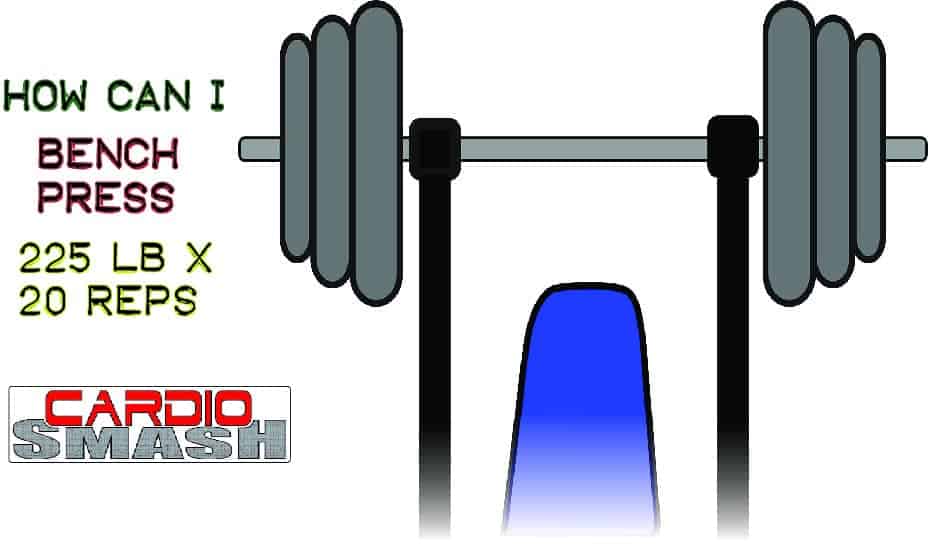Reaching 225 lb on the bench press is an important benchmark for any guy that lifts weights. Whether you are a high school or college football player, concerned with your score on the combine, or an amateur lifter, this is an important metric. Once you are strong enough to bench press 225, you want to be able to do it for as many reps as possible. 10 reps is good, 15 reps is better, but 20 reps is truly impressive. So, what’s the best way to train in order to bench press 225 lb for 20 reps?
I believe that this is achievable for nearly every able-bodied male trainee, and with time, for many female trainees too. There is no need for fancy exercises or countless variations on hand spacing or whatever. Once you are able to bench press 225 lb for 10 reps. Warm up thoroughly, train with 225 lb, and with a slightly heavier weight, alternating, twice a week. Training with the correct weights, the right rep range, and the right training frequency, will push you towards, and then even beyond, the 20 rep range.
There’s also one little-used exercise that can make a big difference…
What’s the approach?
For an example, I will describe the training routine for an individual who can currently bench press 225 lb for 10 reps.
…I will explain how to adjust for people who are at different starting points later…
There are three important factors that we need to consider for this goal:
- Training Frequency
- Volume, Rep Ranges and Weights
- Secret weapon (one additional exercise)
- How To Train Other Body Parts
Training Frequency
Training frequency is the most important factor for this particular goal. If you train chest too often, you won’t fully recover. If you don’t train frequently enough, you won’t progress. I think training twice a week is your best bet.
That being said, you can do some higher rep work with lighter weights on one of the days between chest workouts. It is good to something besides flat bench to give your shoulders a rest. Just focus on getting a pump For example, two or three sets of flyes, or incline press, for 20 reps with 135 lb. Or, say, 50 dips.
Rep Ranges And Weights
Performing bench press only (for chest).
Day 1 :
- 135×20
- Rest/Stretch 3 mins
- 135×20
- Rest/Stretch for 3-5 mins
- 225 x failure
- Rest/Stretch 3-5 mins
- 135 x failure
- Clean and Press for 50+% of your bodyweight.
Day 2:
Train the rest of your body
Day 4:
- 135×20
- Rest/Stretch 3 mins
- 135×20
- Rest/Stretch 3-5 mins
- 245 x failure (up to 10 reps)
- Rest/Stretch 3-5 mins
- 245 x failure
- Clean and Press 3×5 with 50+% of your body weight.
Day 5:
Train the rest of your body
Volume
Although this is only 4 sets for chest, twice a week, the weights and rep count will definitely be a substantial amount of volume. Since the goal is to bench press 225 lb for 20 reps, this will be enough to seriously stimulate your chest and arms, and allow you to progress.
60-80 reps is nothing to sneeze at anyway. The same number of reps would take many sets to reach, if you were training heavier in lower rep sets.
Secret Weapon: The Clean and Press
The addition of clean and presses is a powerful strategic move. I believe that no other exercise, besides actually bench pressing, will contribute more to increasing your bench pressing ability. I believe the Clean and Press to be probably the most effective exercise you can do with a barbell.
The explosive power needed for this exercise will give you added strength from the bench pressing help you go further. It works the entire body, from ankles and calves, to shoulders and forearms, and everything on between! But the overhead pressing part of the movement, in particular, will stimulate new growth in your triceps and deltoids, and really help your stamina in the bench press.
While a difficult exercise to master, and a strenuous one to perform, the clean and press will be the final icing on the cake after blasting your chest and arms with several high rep sets of bench press.
Weights
The idea is that, for each of your two weekly bench press workouts, you warm up thoroughly with 135 lb. Then, for one of these two workouts, you train with 225 lb, and during the other workout you train with a weight that’s a little under 10% heavier, 245 lb.
Guys who can’t get past their ego, or actually think everybody else in the gym gives a crap about how much weight they left, will want to train heavier. However, those heavy singles with 295 lb, 315lb, or whatever, will not really help you for this particular goal.
245 lb is a weight that is noticeably heavier than 225 lbs, but is within a range where you should still be able to get a decent number of reps. If you can bench press 225 lb for 10 reps, you can probably get 245 lb for about 7 or 8. This weight will also strengthen you to a higher level and make 225 lb feel lighter next time.
If you ever get to where you can do 15 reps with that weight, you should increase it by 10 lb.
How To Train The Rest Of Your Body
As long as you have a well rounded routine for the rest of your body, you can pretty much train everything else however you want. Remember, if you are training another body part, for example legs, really really hard, with a ton of volume, that is the part of your body that will get most of the attention from your biological processes. So train your whole body, but don’t push it too hard with other body parts while focusing on this goal.
Definitely keep your back and core strong if nothing else. Some medium-heavy rows and pull-ups will be necessary to maintain the right balance of musculature.
I hope I shouldn’t even have to say to make sure you don’t neglect your legs!
The Day Of The Attempt
When you are finally ready to attempt to beat your record, or you have to show up and perform the combine for (American) football players, there is a little bit of preparation you will need to do.
Rest for a minimum of 48 hours before the event. No pushups, no light work, nothing. You want to be as fresh and as strong as you can possibly be.
Carb loading is good, and caffeine is your friend. I have had my best lifts after eating Grape-Nuts cereal and drinking coffee. Obviously don’t overdo it with the caffeine, but if you like energy drinks or pre-workout supplements and you’re allowed to use them, by all means go for it!
I would warm up for the attempt like this:
2 warmup sets of 10×135 lb
3 minutes rest between each
1 rep @ 225 lb to prime the joints and muscle and mentally prepare yourself.
Rest 3-5 mins.
Max out at 225 lb.
Am I ready for this training?
Of course, if you can barely lift the bar you are not ready for this training program. If, however, you are already able to bench press 225 lb for 10 reps, or 15, and you want to get to 20+, this is perfect for you.
Let me be clear, this is not a beginner program.
So Am I Training For Size? Strength?
The interesting thing about training for this specific goal, is that it defies logic in a sense. One would think that if you can bench press 225 lb for 10 reps, then you would need to become twice as strong to do it for 20 reps. Remarkably, this is not the case. If you can already lift this weight for 10 reps, then you are already strong enough. You just need to most of the weight, and work on muscle stamina.
An example of the similar phenomenon in another sport is the case of Olympic sprinters. Ever noticed how some of those guys will run the 100 m in 9.6 seconds, but will run the 200m in 19.00? Or 18.5?
They are actually running faster in the longer race!
This is a good analogy to explain what you actually need to gain in your performance to master the feat of 225×20.
So this is an anaerobic stamina training technique.
How Long Should I Do This Type Of Training?
Most people will not want to stay on this type of training for longer than a couple of months. this is not designed to be a long-term program, but it is meant to prepare you for a very specific goal. Of course that goal is bench pressing 225 lbs for 20 reps.
If you are a football player with a combine testing coming up, you might want to do this for about a month prior to the event. You should definitely see an increase of 2 to 5 reps within the first 2 weeks, then another 1 or 2 reps per week until you reach your natural limit. Have fun finding that!
How Far Can I Go With This Approach?
Most trainees will be able to get to 20 or beyond. In July of 2016 I did 24 reps with 225lb, at a bodyweight of 195 lb (I’m 5’11” btw). 2 months prior I could only get 14 reps, this is pretty much exactly the training approach I used.
Don’t neglect your other body parts, especially your back! Keep the whole body strong.
Eventually you will want to go back to a mass gaining or cutting routine. But anytime you want to increase your reps at this, or another crucial weight, this technique will be there for you.
What If I Am At A Lower Starting Point?
If you are able to get less than 10 reps with 225 lb, drop the warm-up sets of 20 with 135 lb down to sets of 10, and do a set to failure with 195/205 lb instead of 225. On the heavier workout, use 225 instead of 245. Be honest with yourself, and use a weight that you can get at least 12 of on the lighter day. Once you can get 10 reps with 225 lb, switch to the original weight scheme.
Conclusion
Whether it be for the combine for a football player, bragging rights for a high school student, or just someone that wants to be strong, having two big plates on each side just makes you feel strong, and earns you a little respect from your peers in the gym. When you hit 20 reps with 225 lb you will feel good about yourself and want to tell everybody!


